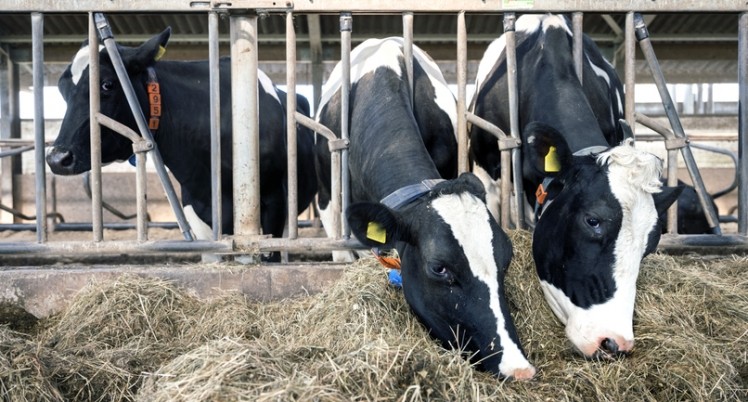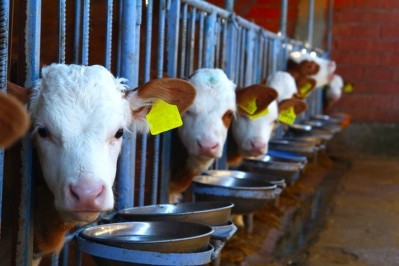Special Edition: Dairy feed trends
Uruguay: Fresh forage and TMR mixed diets may be cheaper, support high milk yield

A team of researchers in at the University of the Republic and the National Institute of Agricultural Research in Uruguay examined the use of fresh forage (FF) and a total mixed ration (TMR) in dairy cow diets and how the feeds affected milk production and nutrient use.
The study was published in the Journal of Dairy Science.
“The objective of our experiment was to determine the effects of feeding cows increasing levels of FF as a proportion of total DMI in a TMR on nutrient intake, rumen digestion, nutrient utilization, and productive performance,” the researchers said.
They found that cows on the higher total mixed ration (TMR) diets had the highest dry matter intake (DMI), but all diets generated similar total nutrient digestibility, mean ruminal pH and total volatile fatty acid concentrations.
Milk yield and ruminal NH3-N concentration were lower for cows on diets with the most forage – but milk fat and milk protein yield were similar for cows on all diets, they said. Cows on the high forage diet had increased unsaturated fatty acids in milk fat and higher levels of linoleic acid, vaccenic acid and rumenic acid than the TMR-based diet.
“We concluded that including up to 29% of FF in the total DMI in combination with a TMR did not affect the intake or digestion of nutrients or the productive response in dairy cows and resulted in a higher concentration of desirable FA from a consumer's perspective."
Why feed fresh forage?
The increasing costs of TMR-based feeds have prompted interest in using fresh forage (FF) in dairy cow diets, the researchers said.
The addition of forage to feeds also has elevated levels of components like vaccenic and rumenic acids, which are considered to have nutraceutical properties.
But dairy cows eating only FF do not have the ability to reach maximum milk production levels because they have a reduced dry matter intake (DMI), they said. The drop in DMI and energy intake lead to a reduction in milk yield.
Past diet research suggests that cows on high forage diets need supplemental energy to reach “maximum productive potential,” they said. Cows on high forage diets also can have low or variable ruminal pH and high concentrations of NH3-N.
“Lower productive performance of animals fed high-quality FF compared with those fed with TMR may be related not only to changes in nutrient ingestion, but also to changes in rumen fermentation and gastrointestinal digestion,” the researchers said. “One of the alternatives to increase performance of FF-fed cows is to use a TMR as a supplement.”
“This feeding system is called a partially mixed ration (PMR) because FF is not physically part of the TMR,” they added.
Research into the use of a PMR has generated evidence that the use of the diet could help cows improve feed intake and have a higher milk yield, they said. But if TMR is provided without limit cows eat little of the forage offered.
“Based on previous results, it would be interesting to evaluate the allocation of pasture as a fixed percentage of the diet instead of increasing the time of access to pasture to promote pasture intake,” they said. However, little work has been done to explore the influence of diets combining TMR and FF regarding nutrient digestion, production and metabolism, they added.
“We hypothesized that cows fed a PMR containing FF up to 25% can attain a similar DMI and milk yield as cows fed only a TMR, and cows fed this diet will produce milk with a higher content of fatty acids considered beneficial for the health of the consumer,” the researchers said.
Feeding trial details
In the feeding trials, 12 cows with a previous milk production record, were given one of three diets for a 20 day period before being rotated to another diet, the researchers said. The 20-day window included 12 days of acclimation and 8 days of data gathering.
The diets included a complete TMR diet (T100), a diet with 75% dry matter (DM) provided by the TMR with 25% in FF (T75), and a diet with 50% of the DM provided by TRM and 50% by FF (T50), they said.
The maximum intake of each cow was measured prior to the start of the experiment, they said.
“Cows assigned to T50 and T75 had a first TMR session, which represented 30% of the preplanned total TMR intake that was to be consumed during the day,” the researchers said. “Once they consumed the total TMR assigned for the session, cows had access to FF. The FF session ended once they completed the total FF intake for each treatment (25 or 50% of total DM offered).”
“After this, cows had access to a second session of TMR, in which they were offered the remaining 70% of the preplanned total TMR intake,” they added.
Feed samples were collected daily for analysis, they said. Daily intake of TMR and FF and feed refusals were noted for days 13 to 20 of each feeding period and apparent total-tract nutrient digestibility and the apparent total-tract digestibility (ATD) coefficient for several nutrients was determined.
Fecal and urine samples were taken on days 13 and 14 of each feeding period, they said. Daily energy balance (EB) also was estimated.
Body weight was recorded at the start and end of each period and average milk composition was noted, they said. Daily N balance was determined and nitrogen (N) levels in urine and manure were established.
Ruminal samples were collected on day 20 of each feeding cycle, and amounts of NH3-N and volatile fatty acids (VFA) were determined, the researchers said. Microbial N flow was estimated.
Milk production was noted from day 13 through 18 and samples were taken on day 15 and 16 for analysis, they said.
Results
Feed and nutrient intake was similar for cows on T100 and T75 diets, the researchers said. However, DMI for the T50 diet was lower than the other diets, as was the nutrient intake although apparent total-tract nutrient digestibility was similar for all diets.
“Inclusion of up to 29% high-quality FF in the diet of cows fed TMR maintained similar levels of DMI and DM digestibility, as well as milk yield, compared with cows fed only TMR,” they said. “However, a 47% inclusion of FF in the diet reduced both DMI and milk yield, although the concentrations of vaccenic, rumenic, and linolenic acids in milk fat were increased, which would result in a healthier food for consumers.”
The energy intake and milk energy output were reduced for cows on the T50 diet, they said. Nitrogen intake, urine N excretion and milk N output were higher in the diets with more TMR, but, fecal N was the same across the diets.
Cows on the T50 diet tended to have improved efficiency in using feed N for milk production, then cows on the T100 diet, they said. N balance was positive for all diets but higher in the T100 diet.
Average ruminal pH was consistent for all the diets, but the range was larger for those on the PMR diets and cows on the T100 diet had a more stable pH, the researchers said. The concentration of total and individual VFA was similar across the diets, but adding FF changed the proportion of propionic and butyric acid.
Average NH3-N concentration in the rumen was lower for cows on the T50 diet, they said. “Total PD [purine derivatives] excretion (mmol/d) and the duodenum FMN [flow of microbial N] were higher for cows in T100 and T75 than cows in T50,” they added.
Milk yield for cows on the T100 and T75 diets was 8.5% higher than cows on the T50 diet, they said. Milk composition was not altered, but cows on the T50 diet had 8% more unsaturated fatty acids, linolenic acid, rumenic acid and vaccenic acid along with an increased MUFA content compared to those on the T100 diet.
“A higher content of rumenic and vaccenic acid for cows in T50 compared with cows in T100 and T75 suggests that the milk of these cows could have healthier characteristics for the consumers, as rumenic acid has nutraceutical properties, among which anticarcinogenic properties are prominent,” they said. “In addition, a higher n-3 fatty acid intake and a diet with a balanced n-6:n-3 fatty acid ratio would benefit consumer health.”
Source: Journal of Dairy Science
Title: Productive performance and digestive response of dairy cows fed different diets combining a total mixed ration and fresh forage
Authors: M. Pastorini, N. Pomiés, J. Repetto, A. Mendoza C. Cajarville
DOI: https://doi.org/10.3168/jds.2018-15389












